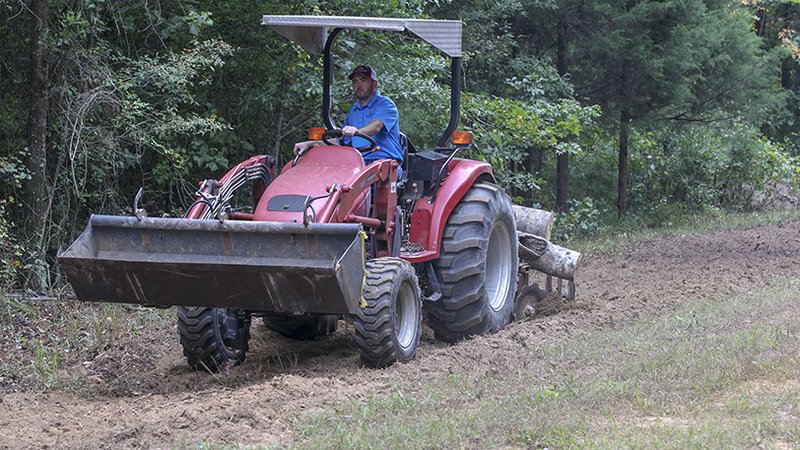Benefits of spring food plots for white-tailed deer on your property
BY Bubba Groves
ON 04-10-2019

April 10, 2019
Bubba Groves
Private Lands Assistant Supervisor
LITTLE ROCK – One of the most popular habitat management strategies utilized by landowners is planting food plots. This is done primarily to enhance wildlife habitat by improving nutrition and the overall productivity of a piece of property.
In some cases, properly implemented food plots can offer up to 10 times the amount of digestible energy and proteins when implemented in conjunction with properly managed forests. By supplementing the natural vegetation that is available for deer, the effects of nutritionally stressful periods can be minimized.
The first step in developing a successful food plot is to determine the objectives of the food plot. These objectives include but are not limited to: wildlife species, time of year, and wildlife nutritional needs. This article will be aimed at meeting objectives for spring food plot plantings for white-tailed deer. These food plots will provide quality nutrition for deer from early spring throughout the summer months. As with any planting, a soil test and proper seedbed preparation should be performed. A lot of money can be wasted by not conducting these two simple but essential steps.
The second step is deciding how much to plant. There is no magical acreage an individual piece of property needs to have, but it is probably a good idea to start out with 1 to 5 percent of the total property. Over time, if the plot becomes over-utilized, more acreage can be devoted to food plot plantings. Generally, food plots planted for forage plots should be in the ½-3 acre range.
Next is deciding what to plant. Various broadleaf herbaceous plants make up a majority of a deer’s diet throughout the growing season. Iron-clay cowpeas, Quail Haven soybeans, and Roundup Ready soybeans are three types of legumes that meet this broadleaf category well that deer will find quite attractive on your property.
Iron-clay cowpeas will provide excellent forage for deer throughout summer and fall especially after the palatability of most native vegetation is decreased. These plants are also more drought tolerant than other species of legumes. Another advantage to planting these types of peas is their grazing tolerance. In areas of high deer populations, this would be an ideal plant to consider. Plant 70 pounds per acre.
Quail Haven soybeans are a re-seeding forage type soybean. These legumes are one of the most highly preferred forages of whitetail deer. The only drawback to these types of legumes is their susceptibility to grazing. It would be recommended to plant this type of legume in areas of lower deer populations or where there is ample acreage that can be devoted to planting this type of plant. Plant 40 pounds per acre.
The last type of plant is the Roundup Ready soybean. By utilizing Roundup Ready soybeans, highly nutritious plots can be kept weed free cheaper and easier. Like the Quail Haven soybean, these legumes are subject to overgrazing as well, so caution should be taken to planting these in areas of high deer densities. Plant 45 pounds per acre.
Planting dates can vary across the state from north to south, but generally these legumes can be planted from April through June. Contact your county extension agent or an AGFC private lands biologist for specific dates for your area and for other food plantings to consider.
Food plots are an excellent way of providing supplemental nutrition for white-tailed deer. However, this should be utilized as only one part of habitat management. Management strategies such as: food plots, timber management, early successional habitat management, and population management should all be used in combination to achieve optimum conditions for white-tailed deer.
For more information on benefits and establishment of food plots for white-tailed deer contact an AGFC private lands biologist at: Eureka Springs, 866-253-2506; Calico Rock, 877-297-4331; Jonesboro, 877-972-5438; Fort Smith, 877-478-1043; Mayflower, 877-470-3650; Batesville, 870-569-8124; Brinkley, 877-734-4581; Perrytown, 877-777-5580, Monticello; 877-367-3553, or Little Rock, 501-539-0889.
Recent News

Arkansas Wildlife Weekly Fishing Report
Jul. 3, 2025
Subscribe to Our Weekly Newsletter E-mails
Don’t miss another issue. Sign up now to receive the AGFC Wildlife Weekly Newsletter in your mailbox every Wednesday afternoon (Waterfowl Reports are published weekly during waterfowl season and periodically outside the season). Fishing Reports arrive on Thursdays. Fill in the following fields and hit submit. Thanks, and welcome!

